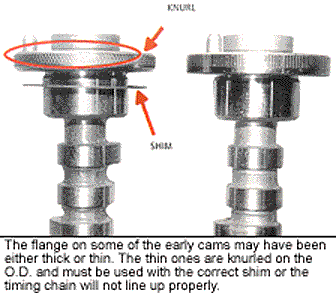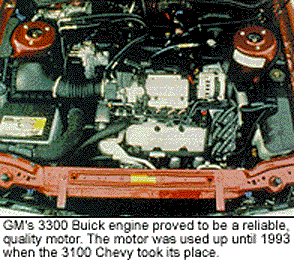 This engine was installed in many of the "A" bodied cars including the Buick Century, the Cutlass Ciera and the Cutlass Cruiser wagon. It was also installed in some of the "N" bodied cars including the Buick Skylark and the Olds Cutlass Calais.
This engine was installed in many of the "A" bodied cars including the Buick Century, the Cutlass Ciera and the Cutlass Cruiser wagon. It was also installed in some of the "N" bodied cars including the Buick Skylark and the Olds Cutlass Calais.
The engine had a smaller bore (3.70" versus 3.80") and a longer stroke (3.16" versus 2.70") than the 3.0L, along with roller lifters and multiport injection. Consequently, it had more torque, more horsepower, better fuel economy, lower emissions (even without an EGR valve), and it weighed 24 pounds less. That’s quite a package!
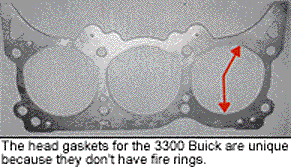
The 3300 was used up through 1993 when the 3100 Chevy became the small corporate V6 for most of GM’s compact and intermediate sized cars. These engines have proven to be exceptionally durable, but they’re finally coming due for a rebuild, so it’s time to take a look at the 3300 and review all of the changes that were made during the few years that it was offered.
Although it was only built for five years, there were three blocks, two cranks, two cams and two heads that add up to four long blocks, so it can be confusing to rebuild. Here’s how it all began and ended:
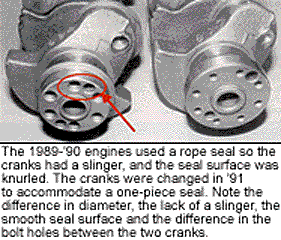
BLOCKS
When the 3300 was introduced in 1989, it had a two-piece rear seal and a straight rail that ran at an angle across the front of the lifter valley to seal the intake manifold. There were no holes for a cam thrust plate because the spring-loaded button in the front of the cam kept it from walking in and out. This early block is a 25532062 casting.
In 1991, the original block was replaced by one that had a one-piece rear seal and three holes in the front for a cam thrust plate. It still had the straight rail that went across the block at an angle to seal the front of the intake. It’s a 25534816 casting. See photo.
In 1992, the block was changed with the addition of two more holes in the front of the block, apparently for a bracket or a mount of some kind. One hole was drilled at the top front corner of the block on the driver’s side, and the other one was drilled perpendicular to the face of the block next to the rail for the intake manifold, so it had a bulge in it for the bolt hole. This block has a 24500498 or a 24502090 casting number. It was used in 1993, too. See photo.
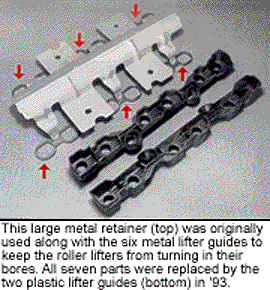
CRANKS
There were two cranks used in the 3300. See photo. The original crank that came in the 1989 and ’90 engines had a small flange (2.655") with six 7/16" bolt holes in it. The seal surface was knurled for the rope seal, and there was a slinger machined on the crank to help keep the excess oil off the rear seal. It’s either a 25532694 or 1235413 casting.
The crank was modified in 1991 to allow the use of a one-piece rear seal. The new crank had a larger, 3.225" flange with eight 7/16" bolt holes, no slinger, and a smooth seal surface. It’s a 25534817 casting. See photo.
CAMS
Buick used two completely different cams in the 3300. The first one that was used in 1989 and ’90 engines came with a flange that measured 2.960". It had a dowel pin and three threaded holes for the cam gear. See photo. The flanges on most of these cams were .418" thick, but there were a few thin ones that measured .387" that were installed along with a special .032" shim to keep the timing chain properly aligned.
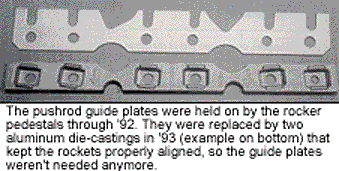
The cams with the thin flange can be visually identified by the knurl on the outside diameter of the flange itself. See photo. Cam movement was controlled with a spring-loaded cam button that was held in place by the front cover.
A new cam that had a snout instead of a flange was introduced in 1991. It used a keyway to locate the cam gear and had one big, threaded hole in the center of the cam for the bolt that held the cam gear on. A circular thrust plate with three holes was bolted to the front of the block to keep the cam in place.
Both the early and late cams used in the 3300s had slightly different specs than the ones that were used in the corresponding 3800s, but the grinds are similar so most rebuilders use them interchangeably. The OEM part numbers of the cams that came in the 3300 and 3800 are as follows:
|
3300
|
3800
|
|
|
1989-’90
|
12338326
|
12338325
|
|
12339315
|
||
|
1991-’93
|
24501457
|
25536869
|
|
25535546
|
24501458
|
|
|
24503401
|
If you prefer to keep them separate by family, you will have to use a "Cam Doctor" or something similar to read the specs off each cam in order to identify them by part number and application; because most of them don’t have any identification on them.
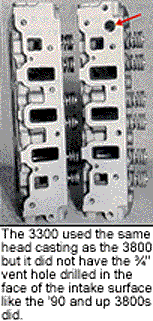
HEADS
There were three heads used on the 3300 with either a 25534250, 24500619 or 24502136 casting number. The only real difference in the heads was the size of the bolt hole for the rocker fulcrums; the 1989-’92 heads came with 3/8? holes and the ’93s had 5/16" holes.
The bolt holes were changed in ’93 because the 3800 engines switched to a roller rocker pivot that had a smaller bolt so there was enough room for the roller bearings on both sides of the rocker stand.
The 1989 through ’92 3300 used exactly the same heads that were installed on the 3800 VIN "C" engines. It shared a common head casting with the 3800 in ’93. They came with the 5/16? bolt holes just like the 3800, but they didn’t have the 3/4? breather hole in the intake surface that was required for the 3800 because of the crankcase ventilation system that was used along with the new plastic intake manifold. See photo.
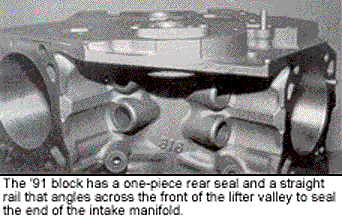
HEAD GASKETS
The head gaskets on the 3300 are unique. They have a perforated metal core with expanded graphite on both sides and no fire rings. See photo. Both the head and deck surface had to be ground and polished to within .002? flatness. The head bolt torque was increased by 15 percent in order to make this special gasket work, but the payoff was less cylinder distortion which meant better oil control and lower emissions.
Most rebuilders have found that the graphite gaskets without the fire rings work on a slightly rougher surface as long as the surfaces are true. They’ve also found that they can use composition head gaskets with fire rings on their regular surface finish.

Back when we rebuilt our first 3300, we checked cylinder distortion with both types of gaskets and found that it made very little difference, so we have done them both ways depending on which gaskets were available in the aftermarket.
VALVETRAIN
All of the 3300 engines used a conventional rocker setup with the pedestal type fulcrums. The 1989-’92 heads had the narrow fulcrums (1.12" O.D.) with narrow rockers (1.15": I.D.) and 3/8" bolts. They used hardened pushrods along with two pushrod guide plates that were held down by the rocker pedestals.
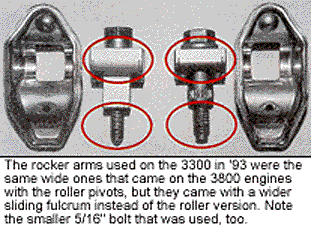
The ’93 engines switched to the same wide rocker (1.18" I.D.) that was used with the roller pedestals on the 3800s, but they used a special, wider sliding fulcrum (1.165" O.D.) with 5/16" rocker bolts instead of the roller pivots. See photo on. This combination allowed GM to standardize its head machining process and use common parts in the valvetrain for both of the Buick V6 engines, except for the fulcrums. Apparently, GM didn’t need any more fuel mileage out of the 3300, so it decided not to spend the extra money on the roller setup.
The pushrod guide plates were eliminated in ’93, too, because the rocker pedestals were held in place by two aluminum die castings (p/n 24501397). The first ’93 engine we saw still had hardened pushrods, but they may have been replaced with some that weren’t hardened later on, so it would be best to check all of them. If you do find some that aren’t hardened, don’t use them in an earlier engine with the pushrod guide plate because they won’t last for long.
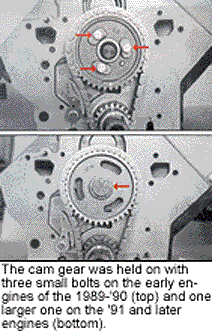
There was one more change to the valvetrain in ’93. Buick replaced the six metal lifter guides and the steel hold-down that had six fingers with two plastic lifter guides that did it all. They are available from GM under p/n 24502738.
COMPLETES
Now that we have all the pieces figured out, how do they all fit together? It actually takes four completes to cover five years. Here are the combinations:
1989-’90
Use a 25532062 block with a two-piece seal, a 1235413 or 25532697 crank and a flanged cam along with a pair of 25534250 heads. The later 24500619 or 24502136 heads with the 3/8" rocker bolt holes can also be used.
1991
Use a 25534816 block with a one-piece seal, a 25534817 crank and the cam with the snout on it, along with a pair of 25534250 heads. The later 24500619 or 24502136 heads that have the 3/8" rocker bolt holes can also be used with the 25534816 block.
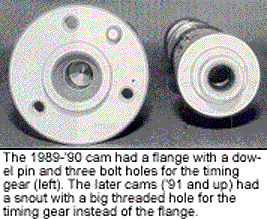
1992
Use the 24500498 or 24502090 block that has a one-piece seal and the bulge on the front intake rail, a 25534817 crank, and the cam with a snout on it, along with a pair of 24500619 heads. The 25534250 or 24502136 heads that have the 3/8" rocker bolt holes can be interchanged.
1993
Use the 24500498 or 24502090 block with the one-piece seal and the bulge on the front intake rail, a 25534817 crank and a cam with a snout on it, along with a pair of 24502136 heads with the 5/16" rocker bolt holes.
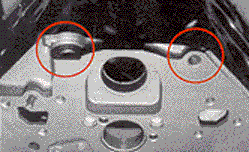
That seems like a lot of completes for an engine that only lasted for five years, but it can’t really be done with less unless you disregard the head and rocker changes in ’93 and combine the ’92s with the ’93s.
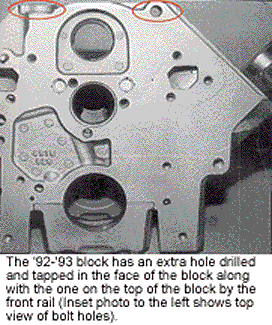
CONCLUSION
That’s the story of the 3300. It was a good engine that had it all – performance, economy and emissions. It’s probably a good thing for our industry that the 3300 didn’t end up being GM’s small corporate V6!
Story from Engine Builder, April 2000
